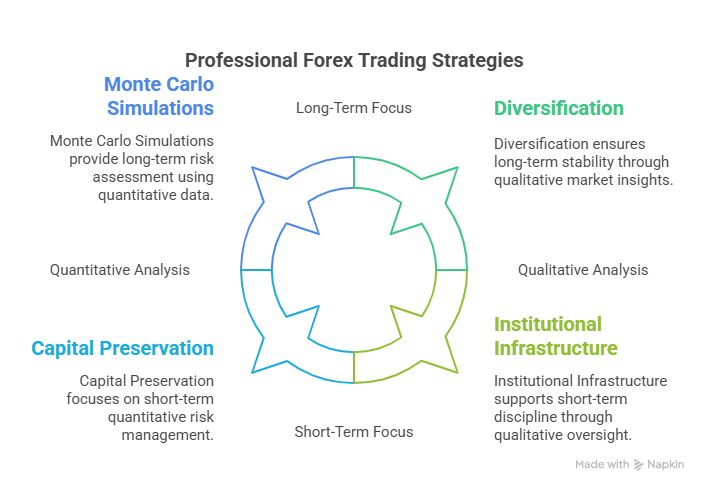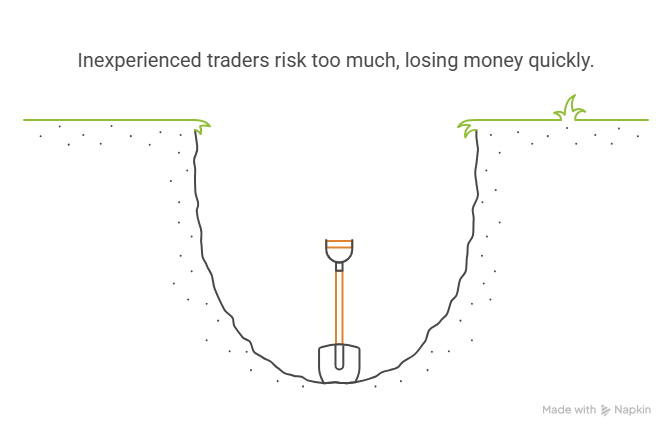When it comes to trading, risk isn’t just a side note — it is the game. Yet, how risk is perceived and managed differs dramatically between professional traders and retail traders. It’s almost like they’re playing two different sports entirely.
Understanding these differences in mindset and methodology can be a game-changer, especially if you’re a retail trader aiming for long-term success. So let’s break it down and dive deep into the real distinctions between how pros and everyday traders approach risk.
Key Differences in Risk Management
If you ever sat behind the scenes at a hedge fund or a proprietary trading desk, you’d notice something immediately: risk is sacred. Professionals build their entire operations around it, while many retail traders treat it as an afterthought — something to think about after clicking “Buy” or “Sell.”
Let’s explore these contrasting worlds:
Professional Traders
- Risk Management as a Science:
Pros don’t “eyeball” risk. They use quantitative models, stress tests, and real-time analytics to measure and predict exposure. For example, a trader at a prop firm might run Monte Carlo simulations to see how a position would perform under 10,000 different scenarios — not because they expect all 10,000 to happen, but to be ready when the improbable strikes. - Capital Preservation First:
One motto heard often in professional circles is: “Live to trade another day.” They would rather take a small, managed loss than swing for the fences and blow up. For instance, risking 0.5% of a portfolio per trade is standard practice — not risking 10% to “catch up” after a loss. - Diversification:
Professionals don’t put all their eggs in one basket. A forex trader, for instance, might diversify positions across major currencies, commodities, and even bond markets. If the USD crashes, they aren’t entirely wiped out. - Institutional Infrastructure:
Pros operate within teams and systems that encourage discipline. A risk manager might walk over and force a trader to cut a losing position. Risk meetings, mandatory stop-losses, and trade reviews are the norm. - Focus on Compounding:
They aren’t obsessed with today’s profits. They’re focused on annual returns and Sharpe ratios (risk-adjusted returns). Compounding 10% per year consistently beats swinging for 50% and blowing up.

Example:
A professional FX trader sees a sudden spike in GBP/USD after unexpected news. Instead of impulsively chasing the move, they pull up their risk model, check their overall exposure to GBP across all positions, and either hedge or reduce exposure if it’s too high — even if it means taking a small loss.
Retail Traders
- DIY Risk Management:
Retail traders often rely on free YouTube videos, Reddit posts, or personal experience. Some have good instincts — but most don’t have the systematic discipline or tools to properly calculate risk. - Overleveraging:
Using 1:100 or 1:500 leverage to turn $500 into $5,000 quickly sounds tempting — but it usually ends in disaster. Many retail traders risk 10%, 20%, or more of their account on a single trade without blinking. - Poor Diversification:
It’s common for a retail trader to put 80% of their capital into a single volatile altcoin or penny stock. One piece of bad news and their account is down 60% overnight. - Emotional Trading:
Without team oversight, emotions run wild. Fear of missing out (FOMO), revenge trading after losses, greed, and panic selling are all too common. - Short-Term Mindset:
Many retail traders dream of replacing their income now. They aim for fast profits, often sacrificing long-term success.

Example:
A retail forex trader sees EUR/USD rallying fast after a news event. Without checking the bigger picture or considering exposure, they triple their normal position size — trying to “make it big.” The pair then whipsaws, and the trader’s account loses 40% in a few minutes.
Comparison Table: Professional vs. Retail Trader Risk Mindset
| Aspect | Professional Traders | Retail Traders |
|---|---|---|
| Risk Management | Advanced models, strict protocols, stress testing | Basic, inconsistent, self-taught |
| Leverage | Used cautiously, within strict rules | Frequently overleveraged for quick gains |
| Diversification | Across multiple asset classes and markets | Focused on few assets or “hot picks” |
| Emotional Discipline | Team support, protocols to limit emotional decisions | Solo trading, high emotional swings |
| Capital | Substantial, backed by institutions | Limited personal funds |
| Technology | Institutional-grade platforms and analytics | Standard retail platforms |
| Trading Goal | Wealth accumulation and risk-adjusted returns | Quick income, often short-term focus |
| Support Network | Collaboration, risk oversight, mentorship | Mostly independent, online community forums |
The Psychology Behind Risk Attitudes
Risk perception isn’t just about math — it’s deeply psychological.
- Professional traders undergo psychological conditioning. They accept that losses are part of the job. If they lose 5 days in a row but followed their plan perfectly, they sleep well at night. Their identity isn’t tied to each win or loss; it’s tied to executing their process faithfully.
Example:
A professional trader may hit their max loss limit by noon and shut down trading for the day — even if they feel “today’s next trade could win it all back.” It’s non-negotiable.
- Retail traders often equate a losing trade with personal failure. This leads to impulsive behaviors like:
- Cancelling stop-losses.
- Doubling position size to “get even.”
- Ignoring clear risk signals.
Without a proper mental framework, small losses snowball into catastrophic ones.
Example:
After three losing trades in a row, a retail trader who initially risked 2% per trade decides to risk 10% “just this once” to recover. Predictably, the next trade also loses, wiping out 30-40% of the account.
Institutional Environment vs. Individual Approach
The environment you trade in massively affects your risk behavior.
- Institutional (Professional) Environment:
Professionals have external constraints:- Daily loss limits.
- Trading desks that monitor real-time risk.
- Risk managers empowered to cut trades.
- Regular team reviews and accountability.
This environment reinforces discipline even when emotions flare.
- Retail (Individual) Approach:
Retail traders enjoy freedom but suffer from a lack of structure. It’s up to them to impose stop-losses, daily limits, and discipline — and many fail. No one is there to pull the plug when things go wrong.
Example:
In a prop firm, a trader exceeding their risk limits would be forcibly logged out or their access temporarily suspended. In contrast, a retail trader at home can keep trading into oblivion until their broker margin-calls them.
Final Thoughts
Professional traders treat risk management as the foundation of their success — not an afterthought. Retail traders often underestimate risk until they experience devastating losses firsthand.
If you’re serious about trading, you must think like a professional about risk, even if you don’t have a trading desk backing you.
Here’s a simple takeaway:
Focus on preserving your capital first — profits will follow naturally.
Learn from the pros:
- Use strict position sizing.
- Always use a stop-loss.
- Accept that losses are inevitable.
- Think in terms of years, not hours.
- Build systems that protect you from your worst impulses.
Trading is a marathon, not a sprint. Master risk, and you master the game.